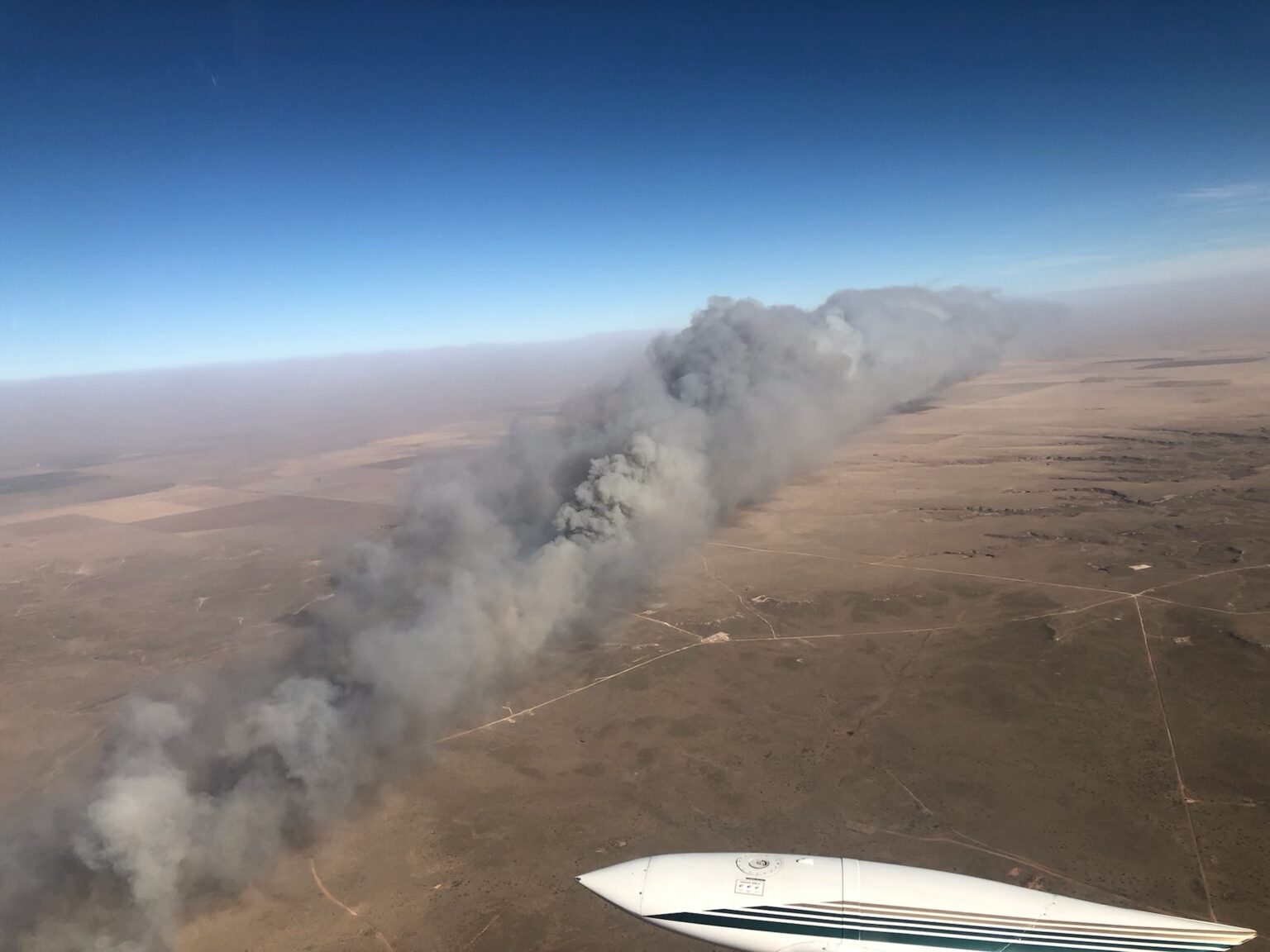Updated 4:35 p.m. Dec. 16, 2021 CST

A large wildfire in Russell and Ellis Counties in Kansas has burned approximately 96,000 acres and destroyed at least 10 homes, according to the Russell County Sheriff. Satellites were still detecting heat on the fire at 3:06 a.m. CST Thursday. The fire is north of Interstate 70, and is northwest, north, and northeast of Russell, about 7 miles from the city. (UPDATE at 1 a.m. CST Dec. 17: The Kansas Forest Service said the “Four County Fire” has burned 365,850 acres.)
The fire was pushed by very strong winds on Wednesday. A weather station at the Russell Airport recorded wind gusts of 100 mph, which is 26 mph higher than the minimum speed for a Category 1 hurricane.
Many other fires were occurring at the same time in Western Kansas and the panhandles of Oklahoma and Texas (see below).
The Kansas Forest Service assessed the situation Thursday morning:
Wednesday pretty much stripped western Kansas of fire resources, between multiple major fires in critical fire weather, and many traffic crashes. Initial assessment indicates that 11 fires burned a cumulative acreage of nearly 400,000 acres. Further damage details are being assessed by local agencies at this time. Multiple resources will committed, likely for several days.
Dust picked up by the winds created visibility problems, requiring some highways to be closed Wednesday.

Eric Metzger, a meteorologist at the National Weather Service in Wichita, told the New York Times that before Wednesday, Kansas had not had any rain for over a month. The state has seen fires in December, when the weather gets dry, he added, but this one felt different.
“I’ve lived out here for more than 20 years,” he added. “This is historic for us.”

Update on two fires in the Texas panhandle mentioned earlier, with information from the Texas Forest Service Thursday afternoon: The North 207 Fire between Pampa and Borger is listed at 23,810 acres. The Parker Creek Fire southwest of Dumas is estimated at 11,066 acres.
Thursday morning the Oklahoma Forest Service said the Cobb Fire in the panhandle had burned about 10,000 acres.
Originally published at 8:57 p.m. Dec. 15, 2021 CST

Very strong winds in Kansas and the panhandles of Texas and Oklahoma caused wildfires to spread very rapidly Wednesday. Blowing dust also caused severe visibility problems, and prompted the street lights to come on at noon in at least one area.
Oklahoma
Due to the Cobb Fire in the Oklahoma panhandle the Guymon Police Department in a 2 p.m. Facebook post on Wednesday encouraged the residents on the northwest side of town to evacuate. Heat data from satellites at 1:55 p.m. CST indicated it had burned approximately 5,000 acres northwest of Guymon. The Oklahoma Forest Service said at 7 p.m. it had grown to about 10,000 acres. The eastward progression toward Guymon had been stopped, they said, and one structure was destroyed. Wind gusts up to 79 mph were recorded in the area.

Texas
Fires in the Texas panhandle were spreading to the east-northeast on Wednesday, also pushed by very strong winds gusting over 80 mph.
The North 207 Fire in Carson County has burned an estimated 15,000 acres about 5 miles southeast of Borger. The Texas Forest Service said it has crossed Highway 152.

The Parker Creek Fire started in Oldam County and spread into Hartley County southeast of Channing, about 14 miles south of Dumas. The TFS said at 6:08 p.m. it had burned 3,500 acres but satellite heat data indicates it could be larger.

Kansas
There are also numerous fires in western Kansas, also pushed by strong winds out of the west measured in at least one location at 100 mph. The New York Times reported that two fires merged in Russell and Ellsworth Counties in the central part of the state to form a massive blaze about 40 miles long, according to Eric Metzger, a meteorologist with the National Weather Service.





